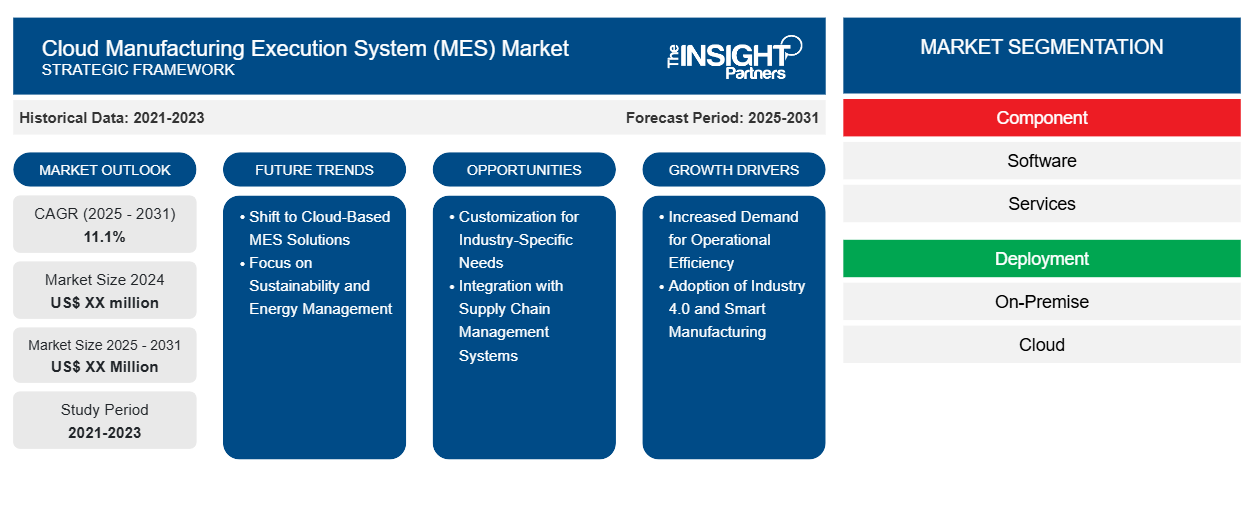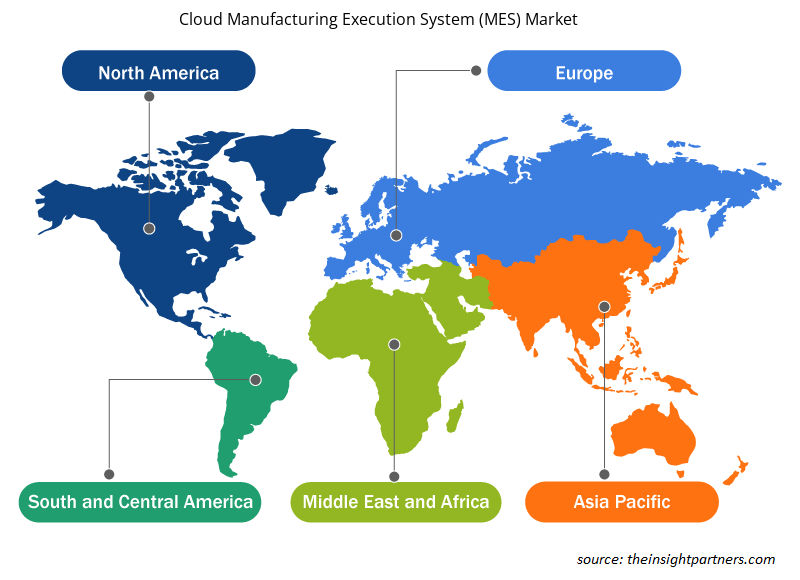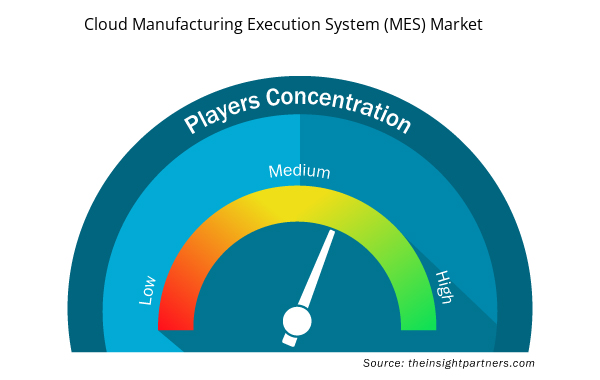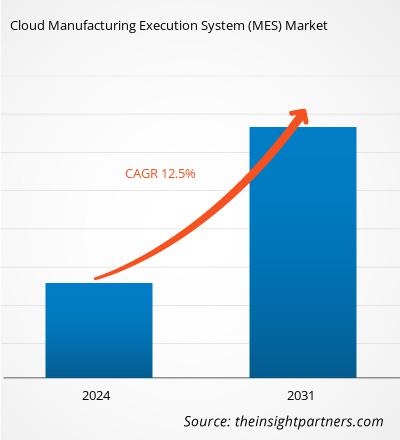Der Markt für Cloud Manufacturing Execution System (MES) wird voraussichtlich von 10,64 Milliarden US-Dollar im Jahr 2024 auf 24,13 Milliarden US-Dollar im Jahr 2031 anwachsen. Für den Zeitraum 2025–2031 wird eine durchschnittliche jährliche Wachstumsrate (CAGR) von 12,5 % erwartet. Die zunehmende Integration der Digital-Twin-Technologie dürfte in den kommenden Jahren neue Trends im Markt mit sich bringen.
Marktanalyse für Cloud Manufacturing Execution System (MES)
Die steigende Nachfrage nach kostengünstigen MES-Lösungen ist einer der Haupttreiber des Marktwachstums. Cloud-MES-Lösungen sind häufig auf Abonnementbasis erhältlich, sodass Hersteller die erforderlichen Rechenressourcen und Softwarelizenzen erhalten, ohne in ihre IT-Infrastruktur investieren zu müssen. Die Integration von Cloud-MES- und Industrie-4.0-Technologien transformiert die Fertigungsbranche, da sie Echtzeit-Konnektivität, verbesserte Analysen, vorausschauende Wartung und verstärkte Automatisierung ermöglicht. Da Cloud-MES-Systeme flexible Anpassungsmöglichkeiten bieten, wird ihre Nachfrage in den kommenden Jahren voraussichtlich steigen. Da Hybrid-Cloud-MES-Lösungen zudem die Übertragung unkritischer Daten in die Cloud ermöglichen, während kritische Fertigungsfunktionen sicher vor Ort verbleiben, wird die Verbreitung von Hybrid-Cloud-MES-Lösungen im Prognosezeitraum voraussichtlich zunehmen. Darüber hinaus wird die Integration der Digital-Twin-Technologie in Cloud-MES-Lösungen voraussichtlich neue Trends auf dem Markt mit sich bringen.
Marktübersicht für Cloud Manufacturing Execution System (MES)
Ein cloudbasiertes Manufacturing Execution System (MES) ist eine hochmoderne Softwarelösung zur Verwaltung und Optimierung von Fertigungsabläufen mithilfe von Cloud-Technologie. Im Gegensatz zu herkömmlichen On-Premise-Systemen, die auf lokale Server und Infrastruktur angewiesen sind, nutzt ein cloudbasiertes MES Remote-Server, um Echtzeitdaten und erweiterte Analysen von jedem Ort mit Internetverbindung bereitzustellen. Dieses System dient als zentrale Schnittstelle für alle produktionsrelevanten Aufgaben wie Planung, Bestandsverwaltung, Qualitätskontrolle und Anlagenverfolgung. Cloud-MES-Software ist auf die reibungslose Interaktion mit anderen Unternehmenstechnologien wie ERP-Systemen ausgelegt und bietet eine einheitliche Plattform für die Verfolgung und Optimierung aller Phasen des Fertigungsprozesses. Der Hauptvorteil eines cloudbasierten MES liegt in seiner Flexibilität und Skalierbarkeit. Hersteller können die Systemfunktionen anpassen, um ihre Produktionsziele ohne hohe Vorlaufkosten zu erreichen. Abonnementbasierte Preismodelle machen diese Systeme zugänglicher, indem sie die finanziellen und technischen Kosten von On-Premise-Alternativen senken. Diese Kombination aus Zugänglichkeit, Integration und Skalierbarkeit macht cloudbasierte MES zu einem unverzichtbaren Werkzeug für Unternehmen, die ihre Produktionssysteme modernisieren möchten.ERP systems, to provide a unified platform for tracking and optimizing each stage of the manufacturing process. The main benefit of a cloud-based MES is its flexibility and scalability. Manufacturers can alter system capabilities to meet production objectives without incurring major upfront costs. Subscription-based pricing models make these systems more accessible by lowering the financial and technical costs associated with on-premise alternatives. This combination of accessibility, integration, and scalability makes cloud-based MES a crucial tool for enterprises looking to upgrade their production systems.
Passen Sie diesen Bericht Ihren Anforderungen an
Sie erhalten kostenlos Anpassungen an jedem Bericht, einschließlich Teilen dieses Berichts oder einer Analyse auf Länderebene, eines Excel-Datenpakets sowie tolle Angebote und Rabatte für Start-ups und Universitäten
Markt für Cloud Manufacturing Execution System (MES):

- Informieren Sie sich über die wichtigsten Markttrends in diesem Bericht.Dieses KOSTENLOSE Beispiel umfasst Datenanalysen, von Markttrends bis hin zu Schätzungen und Prognosen.
Markttreiber und Chancen für Cloud Manufacturing Execution System (MES)
Integration mit Industrie 4.0
Die Integration von Industrie 4.0 und Cloud-MES markiert einen bedeutenden Wandel in der Fertigungsbranche. Industrie 4.0 nutzt Spitzentechnologien wie das Internet der Dinge (IoT), künstliche Intelligenz (KI), Big Data Analytics und intelligente Automatisierung, um intelligente, vernetzte Produktionsumgebungen zu schaffen. Cloud-MES fungiert als Kanal für den Echtzeit-Datenaustausch zwischen Fertigung und übergeordneten Unternehmenssystemen. Diese Fähigkeit ist im Kontext von Industrie 4.0 entscheidend, da schnelle und zuverlässige Daten für die Entscheidungsfindung benötigt werden. Durch die Kombination von Cloud-MES und IoT-Geräten erhalten Hersteller eine ganzheitliche Perspektive auf den Fertigungsprozess und können so Engpässe erkennen, den Anlagenzustand überwachen und die Ressourcennutzung optimieren.IoT), artificial intelligence (AI), big data analytics, and smart automation to build intelligent, interconnected production environments. Cloud MES acts as a channel for real-time data interchange between shop floors and higher-level corporate systems. This skill is critical in the context of Industry 4.0, where rapid and reliable data is required for decision-making. By combining cloud MES and IoT devices, manufacturers receive a holistic perspective of the manufacturing process, allowing them to spot bottlenecks, monitor equipment health, and improve resource utilization.
In Kombination mit IoT-Sensoren und KI-Algorithmen kann Cloud-MES Anlagenausfälle erkennen, bevor sie auftreten. Diese proaktive Strategie reduziert Ausfallzeiten, erhöht die Lebensdauer von Maschinen und senkt die Wartungskosten. Industrie 4.0 und Cloud-MES spielen eine wichtige Rolle im Qualitätsmanagement, indem sie verschiedene Faktoren während des gesamten Herstellungsprozesses überwachen und steuern. Durch die Integration mit fortschrittlicher Analytik und KI erkennt Cloud-MES mögliche Qualitätsprobleme frühzeitig im Fertigungszyklus, eliminiert Fehler und garantiert, dass nur Produkte, die den definierten Anforderungen entsprechen, auf den Markt gelangen. MES ermöglicht eine nahtlose Konnektivität mit Lieferanten, Händlern und anderen Lieferkettenpartnern. Diese Vernetzung erleichtert die Echtzeit-Zusammenarbeit, Bedarfsprognosen und das Bestandsmanagement und führt zu effizienteren und reaktionsschnelleren Lieferkettenabläufen. Die Kombination von Cloud-MES und Industrie-4.0-Technologien verändert die Arbeitsweise von Fabriken durch Echtzeit-Konnektivität, verbesserte Analytik, vorausschauende Wartung und erhöhte Automatisierung. Diese Funktionen ermöglichen es Herstellern, Produktionsprozesse zu optimieren, Kosten zu senken, die Qualität zu verbessern und die allgemeine Betriebseffizienz zu steigern. Mit der zunehmenden Verbreitung von Industrie 4.0-Technologien wird die Nachfrage nach Cloud-MES-Lösungen, die diese hochmodernen Fortschritte unterstützen, steigen und das Marktwachstum vorantreiben.IoT sensors and AI algorithms, cloud MES can identify equipment failures before they occur. This proactive strategy decreases downtime, increases the lifespan of machinery, and lowers maintenance expenses. Industry 4.0 and cloud MES play an important role in quality management by monitoring and managing various factors throughout the manufacturing process. Integration with advanced analytics and AI allows cloud MES to detect possible quality concerns early in the manufacturing cycle, eliminating faults and guaranteeing that only products that match defined requirements reach the market. MES allows for seamless connectivity with suppliers, distributors, and other supply chain partners. This interconnection facilitates real-time cooperation, demand forecasting, and inventory management, resulting in more efficient and responsive supply chain operations. The combination of cloud MES and Industry 4.0 technologies is transforming how factories operate by enabling real-time connectivity, improved analytics, predictive maintenance, and increased automation. These features allow manufacturers to streamline production processes, cut costs, improve quality, and boost overall operational efficiency. As Industry 4.0 technologies become more widely used, the demand for cloud MES solutions that support these cutting-edge advancements will increase, driving market growth.
Wachsende Nachfrage nach maßgeschneiderten Lösungen
Hersteller branchenübergreifend setzen zunehmend auf kundenorientierte Fertigungsstrategien, angetrieben durch die steigende Nachfrage nach maßgeschneiderten Produkten und kürzeren Lieferzeiten. Dieser Wandel erfordert MES-Lösungen, die hochgradig individualisierte Arbeitsabläufe, flexible Produktionspläne und dynamische Lieferkettenverbindungen ermöglichen. Cloud-MES-Systeme ermöglichen es Unternehmen, ihre Fertigungsprozesse an individuelle Kundenbedürfnisse anzupassen. Das System unterstützt bei der Konfiguration von Arbeitsabläufen und Berichtsfunktionen, um die spezifischen Anforderungen von Branchen wie der Automobil-, Luft- und Raumfahrt-, Lebensmittel- und Getränke- sowie Pharmaindustrie zu erfüllen. Darüber hinaus ermöglicht es die Skalierung der Anpassungsmöglichkeiten ohne kostspielige Infrastrukturinvestitionen. Beispielsweise benötigt ein Unternehmen, das individualisierte Medizinprodukte herstellt, möglicherweise eine MES-Lösung, die strenge Qualitätskontrollen, Chargenverfolgung und die Einhaltung von Gesundheitsvorschriften ermöglicht. Eine cloudbasierte MES-Plattform lässt sich leicht konfigurieren, um diese individuellen Anforderungen zu erfüllen.
Im Gegensatz zu herkömmlichen On-Premise-MES-Lösungen sind Cloud-MES-Plattformen anpassungsfähig und skalierbar, sodass Hersteller Funktionen und Features problemlos an ihre betrieblichen Anforderungen anpassen können. Diese Anpassungsfähigkeit ist wichtig für Hersteller in dynamischen Branchen wie der Elektronik- oder Konsumgüterindustrie, in denen sich Produktdesigns und Herstellungsprozesse regelmäßig ändern. Da KMU häufig über individuelle Produktionsmethoden und Ressourcenbeschränkungen verfügen, steigt die Nachfrage nach Cloud-MES-Systemen, da diese ihnen helfen, ihre spezifischen Anforderungen zu erfüllen, ohne dass hohe Anfangsinvestitionen in die IT-Infrastruktur erforderlich sind. Da Hersteller zunehmend nach flexibleren, skalierbaren und branchenspezifischen Lösungen suchen, die sich an ihre individuellen betrieblichen Anforderungen anpassen lassen, wird die Nachfrage nach Cloud-MES-Plattformen in Zukunft voraussichtlich steigen.
Segmentierungsanalyse des Marktberichts für Cloud Manufacturing Execution System (MES)
Schlüsselsegmente, die zur Ableitung der Marktanalyse für Cloud Manufacturing Execution System (MES) beigetragen haben, sind Typ und Endbenutzer.
- Basierend auf den Komponenten ist der Markt in Software und Service segmentiert. Der Markt für Serviceleistungen ist weiter in Professional Services und Managed Services unterteilt. Das Softwaresegment dominierte den Markt im Jahr 2024.
- Hinsichtlich der Bereitstellung ist der Markt in Private Cloud, Public Cloud und Hybrid Cloud segmentiert. Das Public-Cloud-Segment dominierte den Markt im Jahr 2024.
- Je nach Unternehmensgröße ist der Markt in kleine und mittlere Unternehmen sowie Großunternehmen segmentiert. Das Segment der Großunternehmen dominierte den Markt im Jahr 2024.
- Nach Vertriebskanälen wird der Markt in Direktvertrieb und Vertriebspartner unterteilt. Das Direktvertriebssegment dominierte den Markt im Jahr 2024.
- Der Markt ist nach Endverbrauchern in die Prozessindustrie und die diskrete Industrie segmentiert. Der Markt für die Prozessindustrie ist weiter unterteilt in Lebensmittel und Getränke, Öl und Gas, Chemie, Zellstoff und Papier, Chemie, Energie und Strom, Pharmazeutika und Biowissenschaften, Wasser- und Abwasseraufbereitung und Sonstiges. Der Markt für die diskrete Industrie ist weiter segmentiert in Automobil, Elektronik, Halbleiter, Luft- und Raumfahrt und Verteidigung, Konsumgüter, Medizinprodukte und Sonstiges. Das Segment der diskreten Industrie dominierte den Markt im Jahr 2024.
- Je nach Überwachungstyp ist der Markt für Cloud Manufacturing Execution System (MES) in Echtzeit-Temperaturüberwachung, Energiemanagement, Produktfrischeüberwachung, Datenprotokollierung und -analyse und weitere Bereiche unterteilt. Das Segment der Echtzeit-Temperaturüberwachung dominierte den Markt im Jahr 2024.
Cloud Manufacturing Execution System (MES) Marktanteilsanalyse nach Geografie
Der Markt für Cloud Manufacturing Execution System (MES) ist in fünf Hauptregionen unterteilt: Nordamerika, Europa, Asien-Pazifik (APAC), Naher Osten und Afrika (MEA) sowie Süd- und Mittelamerika.
Die USA, Kanada und Mexiko gehören zu den wichtigsten Ländern Nordamerikas. Die Region ist Vorreiter bei der Einführung von MES 4.0, das sich durch die Integration von Industrie-4.0-Technologien wie IoT, KI, maschinellem Lernen und Advanced Analytics auszeichnet. Der Trend zu MES 4.0 wird vor allem durch den Bedarf an intelligenteren, effizienteren Fertigungsabläufen, Echtzeitdaten und nahtloser Konnektivität zwischen Fertigung und Unternehmenssystemen vorangetrieben. Da sich die Industrie zunehmend auf die digitale Transformation konzentriert, bietet MES 4.0 die Infrastruktur für intelligente Fertigung und ermöglicht Echtzeit-Entscheidungen, vorausschauende Wartung und mehr Produktionsflexibilität. Sepasoft bietet MES 4.0 und eine Reihe von Tools, die Continuous Integration und Continuous Deployment (CI/CD) optimieren, Leistung und Stabilität verbessern und einen zukunftssicheren Betrieb unterstützen. Die Changeset-Funktion ermöglicht volle Kontrolle über die MES-Bereitstellung, während die Kompatibilität mit Ignition 8.3 leistungsstarke neue Funktionen wie Event Streams freischaltet.
Branchen in ganz Nordamerika setzen zunehmend auf Cloud-MES-Lösungen, um den Papierverbrauch zu reduzieren, die Dokumentenspeicherung zu vereinfachen, fehleranfällige Prozesse zu eliminieren und den Datenzugriff sowie die Datenanalyse zu verbessern. Darüber hinaus entwickeln die Marktteilnehmer in der Region kontinuierlich Innovationen, um ihren Kunden fortschrittlichere Lösungen anzubieten. So hat Tulip beispielsweise im Dezember 2022 sein Cloud Manufacturing Execution System (MES) in der Amazon Web Services (AWS) Solutions Library eingeführt und bietet Unternehmen eine kostengünstige, skalierbare MES-Lösung. Mit der zusammensetzbaren Plattform von Tulip und dem Echtzeit-Datenzugriff und der Zuverlässigkeit von AWS können Unternehmen ihre Betriebsabläufe mit einem Cloud-basierten MES transformieren.
Regionale Einblicke in den Cloud Manufacturing Execution System (MES)-Markt
Die Analysten von Insight Partners haben die regionalen Trends und Faktoren, die den Markt für Cloud Manufacturing Execution System (MES) im Prognosezeitraum beeinflussen, ausführlich erläutert. Dieser Abschnitt behandelt außerdem die Marktsegmente und die geografische Lage von Cloud Manufacturing Execution System (MES) in Nordamerika, Europa, Asien-Pazifik, dem Nahen Osten und Afrika sowie Süd- und Mittelamerika.

- Erhalten Sie regionale Daten zum Cloud Manufacturing Execution System (MES)-Markt
Umfang des Marktberichts zum Cloud Manufacturing Execution System (MES)
| Berichtsattribut | Details |
|---|---|
| Marktgröße im Jahr 2024 | 10,64 Milliarden US-Dollar |
| Marktgröße bis 2031 | 24,13 Milliarden US-Dollar |
| Globale CAGR (2025 – 2031) | 12,5 % |
| Historische Daten | 2021-2023 |
| Prognosezeitraum | 2025–2031 |
| Abgedeckte Segmente | Nach Komponente
|
| Abgedeckte Regionen und Länder | Nordamerika
|
| Marktführer und wichtige Unternehmensprofile |
|
Marktteilnehmerdichte für Cloud Manufacturing Execution System (MES): Auswirkungen auf die Geschäftsdynamik
Der Markt für Cloud Manufacturing Execution System (MES) wächst rasant. Die steigende Nachfrage der Endnutzer wird durch Faktoren wie veränderte Verbraucherpräferenzen, technologische Fortschritte und ein stärkeres Bewusstsein für die Produktvorteile angetrieben. Mit der steigenden Nachfrage erweitern Unternehmen ihr Angebot, entwickeln Innovationen, um den Bedürfnissen der Verbraucher gerecht zu werden, und nutzen neue Trends, was das Marktwachstum weiter ankurbelt.
Die Marktteilnehmerdichte beschreibt die Verteilung der in einem bestimmten Markt oder einer bestimmten Branche tätigen Unternehmen. Sie gibt an, wie viele Wettbewerber (Marktteilnehmer) in einem bestimmten Marktraum im Verhältnis zu dessen Größe oder Gesamtmarktwert präsent sind.
Die wichtigsten Unternehmen, die auf dem Markt für Cloud Manufacturing Execution System (MES) tätig sind, sind:
- Lehrling FS Inc
- 42Q
- SAP SE
- ABB Ltd
- Schneider Electric SE
- Infor
Haftungsausschluss : Die oben aufgeführten Unternehmen sind nicht in einer bestimmten Reihenfolge aufgeführt.

- Überblick über die wichtigsten Akteure auf dem Markt für Cloud Manufacturing Execution System (MES)
Marktnachrichten und aktuelle Entwicklungen zum Cloud Manufacturing Execution System (MES)
Der Markt für Cloud Manufacturing Execution System (MES) wird durch die Erhebung qualitativer und quantitativer Daten aus Primär- und Sekundärforschung bewertet, die wichtige Unternehmenspublikationen, Verbandsdaten und Datenbanken umfasst. Nachfolgend sind einige der Entwicklungen im Markt für Cloud Manufacturing Execution System (MES) aufgeführt:
- IBASET INC gab bekannt, dass Teledyne CML Composites, Großbritannien, sich für das Solumina Manufacturing Execution System und das Enterprise Quality Management System von iBase-t entschieden hat, um seine Fertigungsabläufe zu revolutionieren. Diese Partnerschaft ermöglicht es Teledyne, Möglichkeiten zur Kosten- und Zykluszeitreduzierung zu identifizieren und umzusetzen und gleichzeitig wichtige Herausforderungen bei der Einstellung und Schulung von Technikern zu bewältigen. (Quelle: IBASET INC, Pressemitteilung, Februar 2025)
- Honeywell hat seine Battery Manufacturing Excellence Platform (Battery MXP) vorgestellt, eine KI-gestützte Software, die den Betrieb von Gigafabriken vom ersten Tag an optimieren soll. Durch die Verbesserung der Batteriezellausbeute und die Beschleunigung der Anlageninbetriebnahme trägt sie dazu bei, die Materialausschussrate zu reduzieren, die bei herkömmlichen Lösungen bis zu 30 % betragen kann. Dies spart Energie- und Materialkosten bei der Skalierung der Produktion. (Quelle: Honeywell, Pressemitteilung, Juni 2024)
Marktbericht zum Cloud Manufacturing Execution System (MES): Umfang und Ergebnisse
Der Bericht „Marktgröße und Prognose für Cloud Manufacturing Execution System (MES) (2021–2031)“ bietet eine detaillierte Analyse des Marktes, die die unten genannten Bereiche abdeckt:
- Cloud Manufacturing Execution System (MES) Marktgröße und -prognose auf globaler, regionaler und Länderebene für alle wichtigen Marktsegmente, die im Rahmen des Berichts abgedeckt sind
- Markttrends für Cloud Manufacturing Execution System (MES) sowie Marktdynamiken wie Treiber, Einschränkungen und wichtige Chancen
- Detaillierte PEST- und SWOT-Analyse
- Marktanalyse für Cloud Manufacturing Execution System (MES), die wichtige Markttrends, globale und regionale Rahmenbedingungen, wichtige Akteure, Vorschriften und aktuelle Marktentwicklungen umfasst
- Branchenlandschafts- und Wettbewerbsanalyse mit Marktkonzentration, Heatmap-Analyse, prominenten Akteuren und jüngsten Entwicklungen für den Markt für Cloud Manufacturing Execution System (MES)
- Detaillierte Firmenprofile
- Historische Analyse (2 Jahre), Basisjahr, Prognose (7 Jahre) mit CAGR
- PEST- und SWOT-Analyse
- Marktgröße Wert/Volumen – Global, Regional, Land
- Branche und Wettbewerbsumfeld
- Excel-Datensatz


- Pharmacovigilance and Drug Safety Software Market
- Virtual Production Market
- Customer Care BPO Market
- Occupational Health Market
- Print Management Software Market
- Power Bank Market
- Wind Turbine Composites Market
- Fill Finish Manufacturing Market
- Small Internal Combustion Engine Market
- Human Microbiome Market

Report Coverage
Revenue forecast, Company Analysis, Industry landscape, Growth factors, and Trends

Segment Covered
This text is related
to segments covered.

Regional Scope
North America, Europe, Asia Pacific, Middle East & Africa, South & Central America

Country Scope
This text is related
to country scope.
Häufig gestellte Fragen
The key players holding majority shares in the global cloud manufacturing execution system (MES) market are Apprentice FS Inc; 42Q; SAP SE; ABB Ltd; Schneider Electric SE; Infor; Korber AG; General Electric Co; Rockwell Automation Inc; Siemens AG; PSI Software SE; EAZYWORKS INC.; Eyelit Technologies; Glorysoft (Shanghai) Co.,Ltd.; Oracle Corp; Autodesk Inc; International Business Machines Corp; IFS AB; FA software (Shanghai) Co., Ltd; Epicor Software Corp; IBASET INC; ANT Sp. z o.o.; NoMuda Ltd; Symestic GmbH; and Tulip Interfaces, Inc.
Growing integration of digital twin technology to play a significant role in the global cloud manufacturing execution system (MES) market in the coming years.
Rising demand for cost-effective MES solutions and integration with Industry 4.0 are the major factors that propel the global cloud manufacturing execution system (MES) market.
Asia Pacific dominated the cloud manufacturing execution system (MES) market in 2024.
The global cloud manufacturing execution system (MES) market is expected to reach US$ 24.13 billion by 2031.
The global cloud manufacturing execution system (MES) market is estimated to register a CAGR of 12.5% during the forecast period 2024–2031.
Trends and growth analysis reports related to Technology, Media and Telecommunications : READ MORE..
The List of Companies - Cloud Manufacturing Execution System (MES) Market
- Apprentice FS Inc
- Epicor Software Corp
- IBASET INC
- ANT Sp. z o.o.
- NoMuda Ltd
- Symestic GmbH
- Tulip Interfaces, Inc
- General Electric Co
- Rockwell Automation Inc
- Siemens AG
- PSI Software SE
- Eyelit Technologies
- Glorysoft (Shanghai) Co., Ltd.
- Oracle Corp
- Autodesk Inc
- International Business Machines Corp
- IFS AB
- FA software (Shanghai) Co., Ltd
- SAP SE
- ABB Ltd
- Schneider Electric SE
- 42Q
- Infor
- Korber AG
The Insight Partners performs research in 4 major stages: Data Collection & Secondary Research, Primary Research, Data Analysis and Data Triangulation & Final Review.
- Data Collection and Secondary Research:
As a market research and consulting firm operating from a decade, we have published and advised several client across the globe. First step for any study will start with an assessment of currently available data and insights from existing reports. Further, historical and current market information is collected from Investor Presentations, Annual Reports, SEC Filings, etc., and other information related to company’s performance and market positioning are gathered from Paid Databases (Factiva, Hoovers, and Reuters) and various other publications available in public domain.
Several associations trade associates, technical forums, institutes, societies and organization are accessed to gain technical as well as market related insights through their publications such as research papers, blogs and press releases related to the studies are referred to get cues about the market. Further, white papers, journals, magazines, and other news articles published in last 3 years are scrutinized and analyzed to understand the current market trends.
- Primary Research:
The primarily interview analysis comprise of data obtained from industry participants interview and answers to survey questions gathered by in-house primary team.
For primary research, interviews are conducted with industry experts/CEOs/Marketing Managers/VPs/Subject Matter Experts from both demand and supply side to get a 360-degree view of the market. The primary team conducts several interviews based on the complexity of the markets to understand the various market trends and dynamics which makes research more credible and precise.
A typical research interview fulfils the following functions:
- Provides first-hand information on the market size, market trends, growth trends, competitive landscape, and outlook
- Validates and strengthens in-house secondary research findings
- Develops the analysis team’s expertise and market understanding
Primary research involves email interactions and telephone interviews for each market, category, segment, and sub-segment across geographies. The participants who typically take part in such a process include, but are not limited to:
- Industry participants: VPs, business development managers, market intelligence managers and national sales managers
- Outside experts: Valuation experts, research analysts and key opinion leaders specializing in the electronics and semiconductor industry.
Below is the breakup of our primary respondents by company, designation, and region:

Once we receive the confirmation from primary research sources or primary respondents, we finalize the base year market estimation and forecast the data as per the macroeconomic and microeconomic factors assessed during data collection.
- Data Analysis:
Once data is validated through both secondary as well as primary respondents, we finalize the market estimations by hypothesis formulation and factor analysis at regional and country level.
- Macro-Economic Factor Analysis:
We analyse macroeconomic indicators such the gross domestic product (GDP), increase in the demand for goods and services across industries, technological advancement, regional economic growth, governmental policies, the influence of COVID-19, PEST analysis, and other aspects. This analysis aids in setting benchmarks for various nations/regions and approximating market splits. Additionally, the general trend of the aforementioned components aid in determining the market's development possibilities.
- Country Level Data:
Various factors that are especially aligned to the country are taken into account to determine the market size for a certain area and country, including the presence of vendors, such as headquarters and offices, the country's GDP, demand patterns, and industry growth. To comprehend the market dynamics for the nation, a number of growth variables, inhibitors, application areas, and current market trends are researched. The aforementioned elements aid in determining the country's overall market's growth potential.
- Company Profile:
The “Table of Contents” is formulated by listing and analyzing more than 25 - 30 companies operating in the market ecosystem across geographies. However, we profile only 10 companies as a standard practice in our syndicate reports. These 10 companies comprise leading, emerging, and regional players. Nonetheless, our analysis is not restricted to the 10 listed companies, we also analyze other companies present in the market to develop a holistic view and understand the prevailing trends. The “Company Profiles” section in the report covers key facts, business description, products & services, financial information, SWOT analysis, and key developments. The financial information presented is extracted from the annual reports and official documents of the publicly listed companies. Upon collecting the information for the sections of respective companies, we verify them via various primary sources and then compile the data in respective company profiles. The company level information helps us in deriving the base number as well as in forecasting the market size.
- Developing Base Number:
Aggregation of sales statistics (2020-2022) and macro-economic factor, and other secondary and primary research insights are utilized to arrive at base number and related market shares for 2022. The data gaps are identified in this step and relevant market data is analyzed, collected from paid primary interviews or databases. On finalizing the base year market size, forecasts are developed on the basis of macro-economic, industry and market growth factors and company level analysis.
- Data Triangulation and Final Review:
The market findings and base year market size calculations are validated from supply as well as demand side. Demand side validations are based on macro-economic factor analysis and benchmarks for respective regions and countries. In case of supply side validations, revenues of major companies are estimated (in case not available) based on industry benchmark, approximate number of employees, product portfolio, and primary interviews revenues are gathered. Further revenue from target product/service segment is assessed to avoid overshooting of market statistics. In case of heavy deviations between supply and demand side values, all thes steps are repeated to achieve synchronization.
We follow an iterative model, wherein we share our research findings with Subject Matter Experts (SME’s) and Key Opinion Leaders (KOLs) until consensus view of the market is not formulated – this model negates any drastic deviation in the opinions of experts. Only validated and universally acceptable research findings are quoted in our reports.
We have important check points that we use to validate our research findings – which we call – data triangulation, where we validate the information, we generate from secondary sources with primary interviews and then we re-validate with our internal data bases and Subject matter experts. This comprehensive model enables us to deliver high quality, reliable data in shortest possible time.

 Holen Sie sich ein kostenloses Muster für diesen Bericht
Holen Sie sich ein kostenloses Muster für diesen Bericht